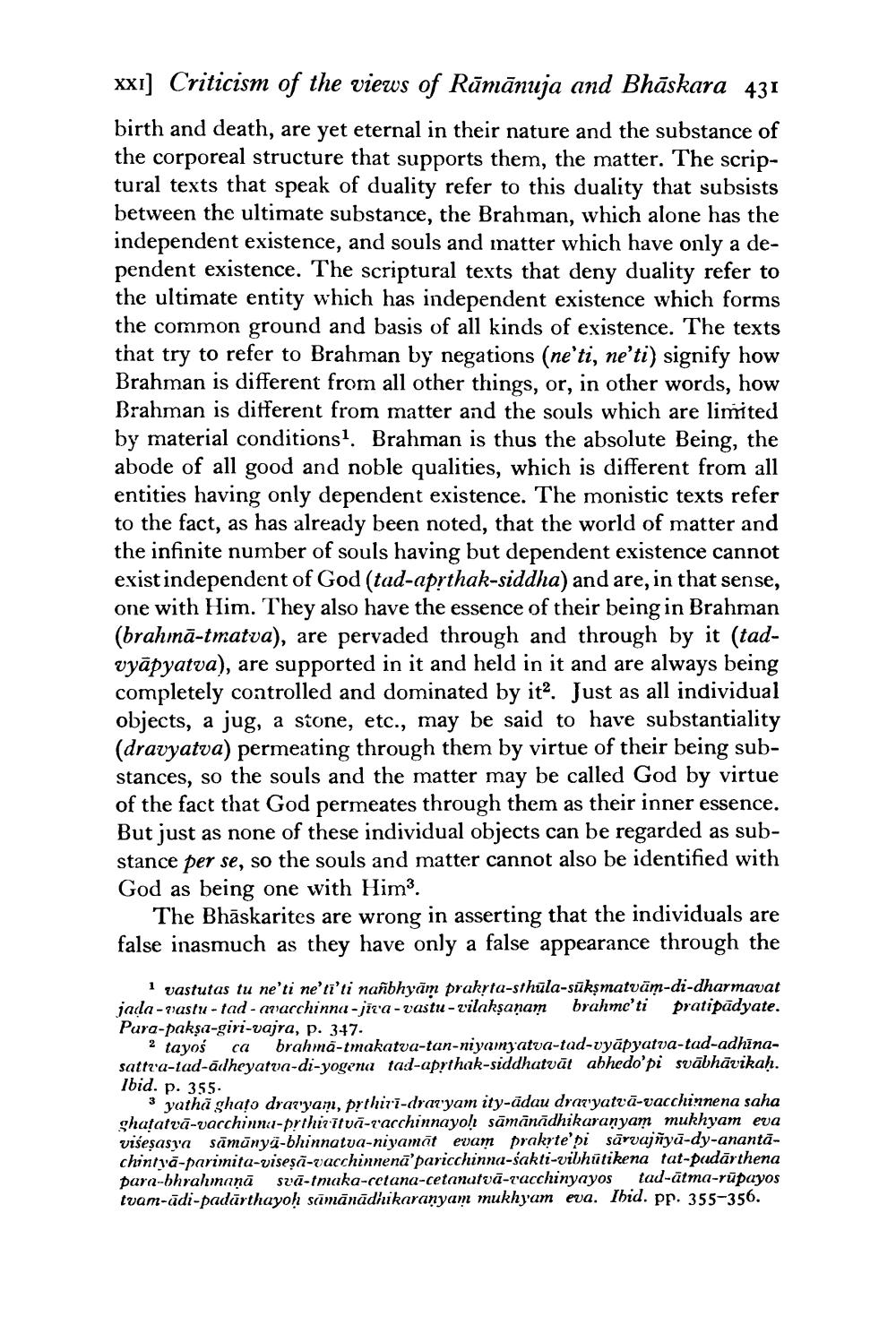________________
xxi] Criticism of the views of Rūmānuja and Bhāskara 431 birth and death, are yet eternal in their nature and the substance of the corporeal structure that supports them, the matter. The scriptural texts that speak of duality refer to this duality that subsists between the ultimate substance, the Brahman, which alone has the independent existence, and souls and matter which have only a dependent existence. The scriptural texts that deny duality refer to the ultimate entity which has independent existence which forms the common ground and basis of all kinds of existence. The texts that try to refer to Brahman by negations (ne'ti, ne'ti) signify how Brahman is different from all other things, or, in other words, how Brahman is different from matter and the souls which are limited by material conditions?. Brahman is thus the absolute Being, the abode of all good and noble qualities, which is different from all entities having only dependent existence. The monistic texts refer to the fact, as has already been noted, that the world of matter and the infinite number of souls having but dependent existence cannot exist independent of God (tad-aprthak-siddha) and are, in that sense, one with Him. They also have the essence of their being in Brahman (brahmā-tmatva), are pervaded through and through by it (tadvyāpyatva), are supported in it and held in it and are always being completely controlled and dominated by ita. Just as all individual objects, a jug, a stone, etc., may be said to have substantiality (dravyatva) permeating through them by virtue of their being substances, so the souls and the matter may be called God by virtue of the fact that God permeates through them as their inner essence. But just as none of these individual objects can be regarded as substance per se, so the souls and matter cannot also be identified with God as being one with Him3.
The Bhāskarites are wrong in asserting that the individuals are false inasmuch as they have only a false appearance through the
1 vastutas tu ne'ti ne'ti'ti naħbhyām prakrta-sthüla-sūksmatväm-di-dharmavat jala-vastu - tad - vacchinnu-jita - vastu-vilakṣaṇambrahmc'ti prati pūdyate. Para-pakş-giri-vajra, p. 347.
2 tayoś ca brahma-tmakatva-tan-niyamj atva-tad-vyāpyatva-tad-adhīnasattra-tad-adheyatva-di-yogena tad-aprthak-siddhatvāt abhedo'pi svābhāvikah. Ibid. p. 355.
3 yathā ghato draw'yam, prthiri-drażyam ity-adau dragyatvā-vacchinnena saha ghatatvā-vacchinna-prthiritva-'acchinnayo! sāmānādhikaranyam mukhyam eva višeşasya sāmānya-bhinnatua-niyamātevam prakrte pi sārvajīyā-dy-anantăchintya-parimita-visesi-vacchinnenā paricchinna-sakti-vibhutikena tat-pudārthena para-bhrahmaņā svā- maka-cctana-cetanutvā-racchinyayos tad-ātma-rupayos tvam-ādi-padārthayoh scīmānādhikaranyam mukhyam eva. Ibid. pp. 355-356.




